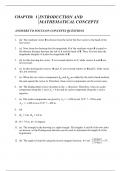CHAPTER 1 INTRODUCTION AND MATHEMATICAL CONCEPTS ANSWERS TO FOCUS ON CONCEPTS QUESTIONS 1. (d) The resultant vector R is drawn from the tail of the first vector to the head of the last vector. 2. (c) Note from the drawin g that the magnitude R of the resultant vector R is equal to the shortest distance between the tail of A and the head of B. Thus, R is less than the magnitude (length) of A plus the magnitude of B. 3. (b) In this drawing the vector – C is reversed relative to C, while vectors A and B are not reversed. 4. (c) In this drawing the vectors – B and – C are reversed relative to B and C, while vector A is not reversed. 5. (c) When the two vector components Ax and Ay are added by the tail-to-head method, the sum equals the vector A. Therefore, these vector com ponents are the correct ones. 6. (b) The displacement vector A points in the – y direction. Therefore, it has no scalar component along the x axis ( Ax = 0 m) and its scalar component along the y axis is negative. 7. (e) The scalar components are given by Ax′ = −(450 m) sin 35.0 ° = −258 m and Ay′ = −(450 m) cos 35.0 ° = −369 m. 8. (d) 9. Rx = 0 m, Ry = 6.8 m 10. R = 7.9 m, θ = 21 degrees 11. (a) The triangle in the drawing is a right triangle. The lengths A and B of the two sides are known, so the Pythagore an theorem can be used to determine the length R of the hypotenuse. 12. (b) The angle is found by using the inverse tangent function, 14.0 kmtan 533.0 kmθ−⎛⎞== °⎜⎟⎝⎠. 2 INTRODUCTION AND MATHEMATICAL CONCEPTS 13. (e) These vectors form a closed four-sided po lygon, with the head of the fourth vector exactly meeting the tail of the first vector . Thus, the resultant vector is zero. 14. (b) The three vectors form a righ t triangle, so the magnitude of A is given by the Pythagorean theorem as 22
xyAA A=+ . If Ax and Ay double in size, then the magnitude of A doubles: () ()2222 2 222 4 4 2 2 .xy x y x yAA A A A A A += + = + = 15. (a) The angle θ is determined by the inverse tangent function, 1tany
xA
Aθ−=⎛⎞
⎜⎟⎝⎠. If Ax and Ay both become twice as large, the ratio does not change, and θ remains the same. 16. (d) The distance (magnitude) traveled by each runner is the same, but the directions are different. Therefore, the two di splacement vectors are not equal. 17. (c) Ax and Bx point in opposite directions, and Ay and By point in the same direction. 18. Ay = 3.4 m, By = 3.4 m Chapter 1 Problems 3 CHAPTER 1 INTRODUCTION AND MATHEMATICAL CONCEPTS PROBLEMS 1. REASONING We use the fact that 1 m = 3.28 ft to form the following conversion factor: (1 m)/(3.28 ft) = 1. SOLUTION To convert ft2 into m2, we apply the conversion factor twice: 2Area = 1330 ft ()1 m
3.28 ft1 m
3.28 ft⎛⎞
⎜⎟⎝⎠2124 m⎛⎞= ⎜⎟⎝⎠ 2. REASONING a. To convert the speed from miles per hour (mi/h) to kilometers per hour (km/h), we need to convert miles to kilometers. This conversion is achieved by using the relation 1.609 km = 1 mi (see the page facing the in side of the front cover of the text). b. To convert the speed from miles per hour (mi/h) to meters per second (m/s), we must convert miles to meters and hours to sec onds. This is accomplished by using the conversions 1 mi = 1609 m and 1 h = 3600 s. SOLUTION a. Multiplying the speed of 34.0 mi/h by a factor of unity, (1.609 km)/(1 mi) = 1, we find the speed of the bicyclists is ()mi miSpeed = 34.0 1 34.0h⎛⎞= ⎜⎟⎝⎠1.609km
h 1m i⎛⎞
⎜⎟
⎝⎠km54.7h⎛⎞= ⎜⎟
⎝⎠ b. Multiplying the sp eed of 34.0 mi/h by two factors of unity, (1609 m)/(1 mi) = 1 and (1 h)/(3600 s) = 1, the speed of the bicyclists is () ()mi miSpeed = 34.0 1 1 34.0h⎛⎞= ⎜⎟⎝⎠ h1609 m
1m i⎛⎞
⎜⎟
⎝⎠1h ⎛⎞
⎜⎟
⎝⎠m15.23600s s⎛⎞= ⎜⎟
⎝⎠ 3. SSM REASONING We use the facts that 1 mi = 5280 ft, 1 m = 3.281 ft, and 1 yd = 3 ft. With these facts we construct three conversion fa ctors: (5280 ft)/(1 mi) = 1, (1 m)/(3.281 ft) = 1, and (3 ft)/(1 yd) = 1. 4 INTRODUCTION AND MATHEMATICAL CONCEPTS SOLUTION By multiplying by the given distance d of the fall by the appropriate conversion factors we find that 6 mi d=()5280 ft
1 mi1 m
3.281 ft⎛⎞
⎜⎟
⎝⎠551 yd⎛⎞+ ⎜⎟⎝⎠()3 ft
1 yd1 m
3.281 ft⎛⎞
⎜⎟⎜⎟⎝⎠10 159 m⎛⎞= ⎜⎟⎝⎠ 4. REASONING The word “per” indicates a ratio, so “0.35 mm per day” means 0.35 mm/d, which is to be expressed as a rate in ft/century. These units differ from the given units in both length and time dimensi ons, so both must be c onverted. For length, 1 m = 103 mm, and 1 ft = 0.3048 m. For time, 1 year = 365.24 days, and 1 century = 100 years. Multiplying the result ing growth rate by one century gives an estimate of the total length of hair a long -lived adult could grow over his lifetime. SOLUTION Multiply the given growth rate by the length a nd time conversion factors, making sure un its cancel properly: mmGrowth rate 0.35 =
d31 m
10 mm⎛⎞
⎜⎟
⎝⎠1 ft
0.3048 m⎛⎞
⎜⎟⎝⎠365.24 d ⎛⎞
⎜⎟⎝⎠ 1y100 y ⎛⎞
⎜⎟⎜⎟⎝⎠42 ft/centurycentury⎛⎞
= ⎜⎟⎜⎟⎝⎠ 5. REASONING In order to calculate d, the units of a and b must be, respectively, cubed and squared along with their numerical values, then combined algebraically with each other and the units of c. Ignoring the values and working fi rst with the units alone, we have ()
() ( )333
2 2m m=
m/s sadcb=→2
m/s()2s⋅2
1m=s Therefore, the units of d are m2/s. SOLUTION With the units known, the numerical value may be calculated: ()
() ( )3
22
29.7m/ s 0 . 7 5 m/ s
69 4.2d== 6. REASONING The dimensions of the variables v, x, and t are known, and the numerical factor 3 is dimensionless. Therefore, we can so lve the equation for z and then substitute the known dimensions. The dimensions [] [] L and T can be treated as algebraic quantities to determine the dimensions of the variable z.





